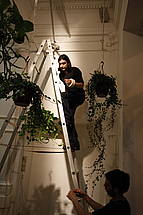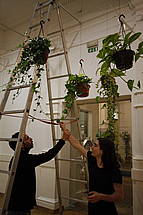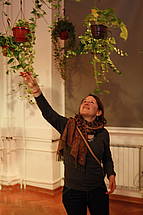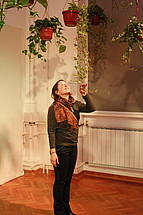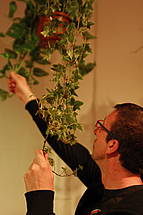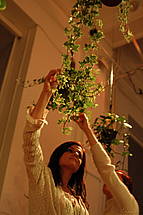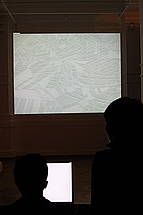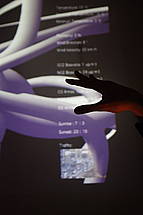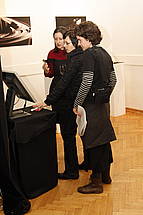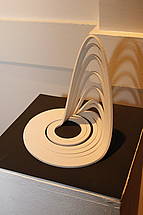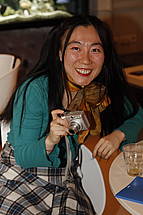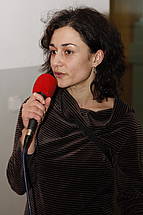
| News | Events | Archive | About us | Partners | Projects | For the media | Contacts |
Areas of conflu(X)ence
Friday 4th April 2008 at 8 pm - the opening of the group exhibition
Areas of Conflu(X)ence – Območja stekanja
Selection from Sibiu in Luxemburg - European capitals of culture 2007
Curator: Tincuta Heinzel Parv
Artists: Florian Grond & Gabriele Engelhardt &Thomas Kienzl, Filipe Jensen & Nuno Costa, Claudia Robles, Scenocosme (Gregory Lasserre in Anaïs met den Ancxt), Effie Wu
Tincuta Heinzel Parv, a curator of Romanian origin, living in Paris, has conducted a number of international projects, the latest one - in cooperation with Quentinom Drouet - being Areas of Conflu(X)ence, which connected two European capitals of culture (ECOC) in 2007, Luxemburg and Sibiu, Romania, at the same time relating to upcoming capitals. It focuses on digital creativity and informs the public about the peculiarities of such artistic approach and about various practices it emphasizes. European artists used the topic of "landscape" to research various ways of understanding that are offered by new media and digital technologies, the emphasis being on works and appliances developing an interactive relation between several distant places. Art wishes to be the point of confluence of various fields – physical points, such as urban centres, exhibition spaces and works as well as creators and other participants, and of the Internet as the virtual and global side. The presentation in Maribor included a selection from the exhibition Areas of conflu(X)ence (Sibiu/Luksemburg 2007).
Florian Grond
Florian is born in Graz (Austria) 1975. He studied Chemistry at the Karl Franzens Universty in Graz, at the De Montfort University in Leicester and at the Eberhard Karls University in Tübingen.Since 2002 he works at the ZKM (center for art and media) in Karlsruhe Germany.His work focuses on nonlinear systems, scientific sonification and media art.
Since 2002 he published several articles in peer reviewed scientific journals, and since 2004 he participated in media art exhibitions in Germany (Karlsruhe), Austria (Graz), Switzerland (Aarau), Denmark (Esbjerg), Italy (Genoa) and Japan (Hakodate and Tokyo).
Gabriele Engelhard
She studied Education for children with special needs and History. Later she turned to sculpture, media art and photography. One recurring theme in her photographic work is the modeling of landscape as sculpture.
Thomas Kienzl
He studied Architecture in Graz. In 1994 he founded Kommerz, a company specialized in developing interfaces in the fields of interaction design and visual media.
_zur form - an interactive mixed media installation
Idea, production: Florian Grond
Concept, production, design: Thomas Kienzl
Photo: Gabriele Engelhardt
Interactive 3D programming, interaction design: Ulf Marsche, Otti Brosch, Kamil Jozwiak, Peter Uray
_zur form (_on form) is a collaborative mixed-reality installation by Florian Grond, Thomas Kienzl and Gabriele Engelhardt. In it, mathematical formulas are transformed into 3D forms and are presented as sculptures together with a tangible mixed reality installation. The project also features photographs of the support forms, the negative casts that emerge out of the form production process.
_zur form makes a contemporary contribution to the well-established tradition of representing mathematical functions as 3D forms, which dates back to 19th-century Germany. The early forms inspired a number of artists in the 19th and 20th centuries, and also became the point of departure for the conception of our project.
In German, the word "begreifen" (to understand) literally means to grasp an idea, as with a hand. The transformation of formulas into forms also emphasizes the original meaning of the word "information," which is "bringing into form." Thus, by making tangible objects out of abstract mathematical concepts, the sculptures and their representations underline both the material and physiological aspects that pertain to the construction and accessibility of knowledge.
The represented forms emerged out of Florian Grond's research into the stability of chaotic attractors, which are solutions to nonlinear differential equations. Grond developed algorithms that accentuate the curious topological properties of chaotic attractors.
Thomas Kienzl developed a tangible mixed reality interface (MRI) for the project. The MRI allows for a tactile manipulation of the mathematical objects in virtual space. Gabriele Engelhardt's photographic work focuses on various sculptural elements. With her photographs of the negative casts of these forms, Engelhardt extends the tradition of using mathematical functions as model objects in the history of photography.
Nuno Costa
Born in 1983. In 2001 finished his studies on communication and image and he took a specialization in multimedia in the « Soares dos Reis » school. He graduated in 2006 from the Catholic University where he studied image and sound and namely the digital art specialization. He followed a trainship at CITAR CITAR (Centro de Investigação em Ciências e Tecnologia das Artes), He presently works as freelance and he is launching a company with his parteners Filipe Jensen and the engineer Nuno Rodriques.
Filipe Jensen
Filipe studied environment engineering at the Biotechnology University in Porto, Portugal, before tackling the sound and image field and namely the digital art specialty at the Portuguese Catholic University. He was a trainee at ZKM (Zentrum fur Kunst und Medientechnologie) in Karlsruhe, Germany. Presently, Felipe works at CITAR (Centro de Investigação em Ciências e Tecnologia das Artes), at the Catholic University, where he’s undertaking with Eduardo Condorcet « House of Affects Project ». He also participates to the AML (Akustik Musik Labor) and LeinKlang projects in partnership with ZKM.
COLONY
Production : 2005/2006 - Universidade Católica Portuguesa
Keywords : Artificial Life, Bioart, generative, city, interactive interface
Colony is a project that incorporates multiple concepts connected to a city, and all data related to the city. Colony is a 3D generated organism composed by a nucleus and several tentacles that behaves according to real-time data extracted from the internet. All data is relative to Porto city. For instance the amount of rain will control the thickness of the tentacles. Colony provides a physical interface, using computer vision, that provides the user to explore Colony visualization.
This project characterizes-itself by the construction and development of a three dimensional and virtual object, that acts like a sensible and sensory organism to the pertinent information of a city, in this case, the Porto city. From the moment that the virtual object became reactive and with an independent behaviour, not lineally programmed, it was by us elevated to the statute of a being. Therefore, this being is modelled in real time, through the interpretation of the information collected by some of the computerized nets of the city, the data is kept in a determined number of variables regarding the aforesaid information. Colony possesses an interface that promotes the participation of users. The degree of interaction is small, but provides the user to see all angles of Colony.
All the variables that build and control the behaviour of the being, were extracted from the internet, for instance the temperature, the quality of the air, even the city traffic cameras were captured. Visually all this information is converted in a three dimensional content, with an oval nucleus, of which several tentacles are sprout. The interactive interface consists of a frame with a ball in the center set by two elastics that are situated in the average of the frame. Through the manipulation of the ball, entirely intuitive, is possible perform actions of zoom and rotation to the viewing of the being. Colony is a being that feeds of the own life of the city, manifesting itself positive or negatively according to the metropolitan health of Porto city.
Claudia Robles
Born in 1967 in Bogotá, Columbia. Claudia graduated in 1990 from the J. Tadeo Lozano University of Arts in Bogota. After the graduation, she followed other studies in the field of the animated films in Italy, as well as in the field of electronic composition in Folkwang-Hochschule in Essen, Germany and a Master of degree in Media Mix in Ecole Supérieure d’Art Visuel in Geneva. For her sound and image composition „Bewegung in Silber“ (Silver Movement), she received the 2nd prize of the „Hören und sehen“ (Hear and see) competition, organised by ZKM and Institut für Neue Musik of Darmstadt. She took part to various group and solo exhibitions namely in Bauhaus-archiv Museum für Gestaltung Berlin (2003), in Goethe Institute Bogota (1999), and in Bauhaus Dessau (2002 et 2001). Since 2004, she has been working as an artist-in-residence of the ZKM (Art and Technology Media Centre) in Karlsruhe. In May 2005, she presented her work Seed/Tree (sound and image installation / butoh performance with live electronics) in solo exhibition.
KONFLUENTIA
« …. and in his dreams now cities light as kites appear, pierced cities like laces, cities transparent as mosquito netting, cities like leaves’ veins, cities lined like a hand’s palm, filigree cities to be seen through their opaque and fictitious thickness »
Italo Calvino.
Konfluentîa is an interactive installation, which consists on imaginary geographical maps created from multiple satellite images of different cities.
Every visitor has the opportunity to create new maps, new formations, new passages, making visible imaginary places, intersections and landscapes.
These new creations are mixed up with stuctures from nature like spiderwebs, lines of the hand, honeycombs or corals – creating another kind of confluence between urban and natural structures.
Scenocosme (Grégory Lasserre & Anaïs met den Ancxt)
The Scenocosme (www.scenocosme.com) artists Grégory Lasserre and Anaïs met den Ancxt mix interactive art, music and architecture and so they conceive evolving and original works. Using multidisciplinary expressions, they reactivate the meanings of the space and of the sensitive creation. They invite the public to collective musical or choreographic performances.
Akousmaflore
Sensitive and interactive musical plants
Akousmaflore is a small garden composed of living musical plants or flowers, which react to human gestures and light contact. Each plant reacts in a different way to contact or heat by a specific sound. The plant language occurs through touch and the close proximity of the spectator.
Our invisible electrical aura acts on the plant branches and encourages them to react. The plants sing when the audience lightly stroke or pass in the immediate vicinity to them. A flower concert is created. In our artwork, we create hybrids between plants and digital technology. Plants are natural sensors and are sensitive to various energy flows.
Digital technologies permit us to have a relationship with plants and sound.
We display the effects of random data flow and plant interaction. The data is modified as the spectator meanders around and touch the installation, resulting in a random musical universe. Audience gestures and movements generate sound effects and changes in the texture of the sound.
Effie Wu
Born in Taipei Taiwan. Effie studied performing arts at the National University of the Arts in Taipei, Taiwan. Afterwards founded the rock band “Cat Fight” (album “Cat Fight, Cut out”, Crystal Independent, Taipei, 1999). Between 1999 and 2002 lived in Florence, Miland and Munich. In 2002 moved to Berlin. 2004-2007 studied Media Art in the class of Prof. Vedder and Prof. Sauter at the University of the Arts Berlin. In 2006 she worked for Pipilotti Rist. Since 2007 Master study at the University of the Arts Berlin.
Her Works were shown at the International Media Art Biennale Poland, the Taipei Fine Arts Museum Taiwan and the Europe Media Art Festival Osnabrück (EMAF) Germany. etc.
Website: Effiewu.com
Zero is a videosculpture of one meter height, consisting of a circular projection screen, mounted on a plexiglas foot and driven by a otor with gear. The projection screen shows the 360 degrees view of an inner courtyard, consisting of 24 motion pictures which are arranged in form a wheel. On the 12 (or also 0) clock position, there’s a woman walking through the courtyard, which means, that she is walking out of one picture into the next, while the movie’s background is turning behind her. Projected film and the texture of the slowly turning projection screen are linked. the projection screen is painted from hand and therefore makes an impression comprable to vintage photos. Due to the sae turning speed of the video and of the motor-driven projection screen, both become integrated, the video becomes physical, as if the original film material would have been fixed on the screen. This is intensified, by projecting the video on a round surface, instead of using the usual rectangular framework together with a black mask. The sound of the motor and the squeaki,g of the gear strengthen this poetic movement. Above the plexiglass foot, the film appears free flotting, like a kind of planet. It is autonomous, diconnected from the outside, a private small world with its own rhythm and own speed. And it’s very peacefull.
The woman in this world reminds of "The small Prince", but she doesn’t follow the sunsets, instead she keeps turning the planet. she’s walking relaxed but determined, throught the panorama of pictures, through different time segments and spaces. Continuously throught her life. Comparable to the days of our lifetime, where we pass through the zero point again and again. There is neither a point of beginning nor an end point, everything is infinite, like life is allways passed on.
In a sense the content of the work is ZEN. The wheels turn in at a very calm rhythm, meditative with long time contemplation. Therefor the medium video is liberated from its rectangular form. Instead the projection screen is round, the form of infinity or Buddhism. We try to understand the nesting of the 360 degree space in the video, together whith the motor driven screen. This is similar to the reflection about the paardoxical statement of a koan. It leads to peace. In Buddhism the jourey of the soul does not exist of passing through one life, but many lives, everyone with birth and death, while every time the soul has different tasks to fulfil, born as whichever life-for. We continue to ive in our own wheel, on the own way, whith our own mission. We posses our own wheel of life, our own planet and our way never stops, like a clockwork. Each instant is a piece of eternity.
The exhibition will be on view until 19/04/2008.
Kibela, space for art, is open every day 9.00 am to 10.00 pm, Saturdays 4.00 pm to 10.00 pm, and closed Sundays.
Photo gallery
Sections
KIBLA PORTAL
KiBela, space for art
- archive
- technical rider
artKIT
KIBLA2LAB
Informal education
Accompanying art program
Coproductions
KiBar: cybernetic bar
Za:misel bookstore
TOX
folio
Festivals
KIBLIX
MED
Festival of Love 2008-2012
Days of Curiosity
(DA)(NE)S
Projects, Coproduction and International Cooperation
Current Projects
Coproductions
Past Projects
Subscribe to newsletters
Find us on:
E-Excellence Award 2008
|
telefon: 059 076 371 ali 059 076 372 / e-pošta: kibla@kibla.org


















